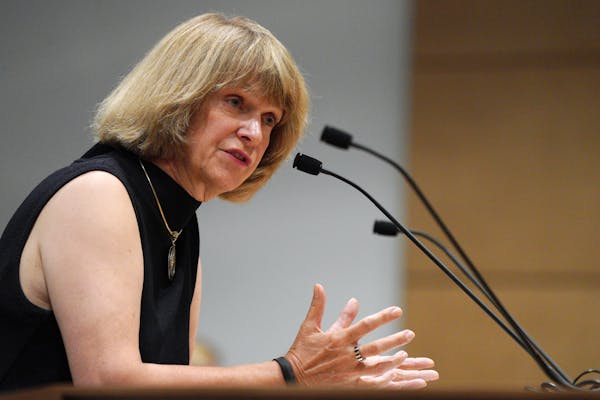Minnesota's largest state agency monitors day care centers. It oversees the Medical Assistance program and provides cash assistance and benefits. It runs mental health hospitals and specialty dental clinics.
The sprawling Department of Human Services serves at least a quarter of the state's population. And it's in the middle of a historic overhaul after years of scrutiny.
State leaders decided last year to divide the more than $20 billion department into three entities, saying the change will allow the agencies to be more nimble and better serve Minnesotans. The move followed years of audits showing the DHS failed to provide sufficient financial controls, as well as repeated calls from legislators to break up the mega-agency to improve accountability.
"Creating a new state agency doesn't solve all the problems and fund all the asks tomorrow," said Erin Bailey, co-chair of the steering committee overseeing the creation of a Department of Children, Youth, and Families. But she told lawmakers this week, "We have to look inside the house and think about how we do our work differently if we want to see and experience different results."
The state will establish that agency and have a commissioner in place by July 1, although some programs won't shift to the new agency until 2025, according to a report published this month that provides the latest look at the complex transition.
Next year, Direct Care and Treatment will splinter off from the DHS. That division employs about 4,700 people and is responsible for the state's behavioral health hospitals, substance use treatment facilities and many other programs.
Here's what you need to know about the changes.
What will each of the three agencies do?
Department of Children, Youth and Families: Various state programs will merge under this new department. It will handle licensing for child care providers as well as child safety, foster care and adoption work. The department is taking over juvenile justice and youth intervention programs that the Department of Public Safety administers, and will run some education-related services like early learning scholarships and the Early Childhood Family Education program.
The new agency will also be responsible for a number of cash assistance programs, including some related to housing and hunger.
Direct Care and Treatment: This existing division of the DHS runs a health care system that has roughly 200 sites across the state. Those locations include psychiatric hospitals, inpatient substance abuse treatment centers, a sex offender treatment program, group homes and vocation programs for people with disabilities. The leadership of the program will shift with the transition, but DHS officials said the work of the division will not change dramatically.
Department of Human Services: The slimmed-down version of this agency will still administer a number of programs but much of the agency's focus will be running the state's Medicaid program.
Are my services going to change?
No. Minnesotans don't need to do anything at this point to ensure their services continue and shouldn't expect changes to programs, DHS Chief of Staff Stacy Twite said. The state supervises human service programs but counties and tribes generally administer them, and that won't change, she said.
"We are really trying to aim to make this as seamless as possible for folks," Twite said. "Disruption in services is the last thing we want."
Why split up DHS?
Lawmakers have raised concerns for years about the agency's ability to adequately oversee and manage its multitude of programs.
When Gov. Tim Walz pitched his plan to split up the agency last year, he said the current structure, with the DHS overseeing everything from day cares to treatment for sex offenders, "makes no sense."
State leaders hope the new structure of the Department of Children, Youth and Families will reduce disparities across race, income and ZIP codes. It is supposed to improve access and delivery of services and better promote needed funding and policy changes for kids and families, according to the new transition report.
Conversations about splitting off Direct Care and Treatment into its own agency had been happening for years before state leaders opted last session to make the change. That large division provides specialty direct care to clients, and officials said the change is going to allow it to operate more like a health care system.
A five-person executive board is going to start overseeing Direct Care and Treatment. Board members are supposed to have relevant experience, such as serving on a hospital or nonprofit board, working in health care or coordinating behavioral health care.
Once the DHS has a narrower scope, it will be able to focus on improving core services, like Medicaid, and can invest in minimizing errors, Twite said.
How much will this change cost?
The full cost won't be clear until the transitions wrap up. However, lawmakers devoted $20.3 million in the current two-year budget to create the Department of Children, Youth and Families and $7 million over the following two years for the new agency.
Another $7.8 million was dedicated for the Direct Care and Treatment transition in the current budget and there's $7.5 million in the next two-year budget.
What will happen to the agency's employees?
About 7,100 people work for the Department of Human Services, making it one of Minnesota's larger employers. DHS officials have said they do not intend to lay off workers.
Roughly 4,700 of those employees work in Direct Care and Treatment and that number is not supposed to change much when the department splits off into its own agency. The law creating that new agency states: "No transferred employee shall have their employment status and job classification altered as a result of the transfer."
The Department of Children, Youth and Families, which will pull together employees from the state's human services, education, public safety and health departments, is expected to have around 900 workers.
Approximately 2,100 employees will remain under the Department of Human Services.
